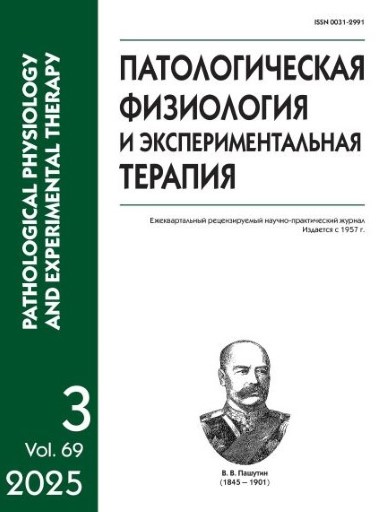Morphological and morphometric characteristics of the liver in exposed to ferrihydrite nanoparticles
Abstract
Introduction. Ferrihydrite nanoparticles (FNPs) are promising for various biomedical applications. However, the use of FNPs is associated with biosafety issues. The liver is one of the critically important organs exposed to nanomaterials. It plays a central role in metabolism and detoxification, and its damage can lead to serious adverse consequences. Therefore, studying effects of FNPs on the liver is a relevant and important task. The aim of the study was to evaluate the effect of FNPs on the liver morphological structure after oral administration, depending on the method of FNP synthesis.
Methods. The experiment was performed on 3 groups of laboratory mice (males, n=55): group 1 (n=15), control that was fed food not supplemented with FNPs; group 2 (n=20), experimental group, was fed food supplemented with synthetic FNPs; group 3 (n=20), experimental group, was fed food supplemented with biogenic FNPs. The feed mixture for the experimental groups was prepared in a laboratory mixer SL-12pnd. Biological material was sampled on days 1, 22, and 36 of the experiment. Liver samples were prepared according to standard histological methods and stained with hematoxylin-eosin, and with Perls Prussian blue to detect iron nanoparticles. The morphometric analysis of liver tissue was performed using the ViodeoTesT-Morphology 7.0 software. The significance of cross-sample differences (p) was assessed using the Mann−Whitney U-test. The significance of differences between dependent samples was assessed using the Wilcoxon T-test. Differences were considered statistically significant at p<0.05.
Results. The administration of FNPs with food leads to statistically significant changes in the morphometric parameters of the liver. In experimental groups 2 and 3, the diameter of the interlobular veins was significantly increased, which was associated with a decrease in the central vein diameter. The proportion of non-nuclear hepatocytes was markedly increased in both groups. Also, the liver tissue showed inflammation signs with varying intensity of pathological processes resulting in the impairment of the liver compensatory capabilities.
Conclusion. The study showed a negative effect of FNPs (both synthetic and biogenic) on the liver manifested in the form of necrobiotic changes in the liver parenchyma.
Downloads
References
2. Meng Y.Q., Shi Y.N., Zhu Y.P., Liu Y.Q., Gu L.W., Liu D.D. et al. Recent trends in preparation and biomedical applications of iron oxide nanoparticles. Journal of Nanobiotechnology. 2024; 22:24. https://doi.org/10.1186/s12951-023-02235-0
3. Shen S., Huang D., Cao J., Chen Y., Zhang X., Guo S., et al. Magnetic liposomes for light-sensitive drug delivery and combined photothermal–chemotherapy of tumors. Journal of Materials Chemistry B. 2019; 7 (7): 1096–106. https://doi.org/10.1039/C8TB02684J
4. Samrot A.V., Sahithya C.S., Selvarani A.J., Purayil S.K., Ponnaiah P. A review on synthesis, characterization and potential biological applications of superparamagnetic iron oxide nanoparticles. Current Research in Green and Sustainable Chemistry. 2021; 4: 100042. https://doi.org/10.1016/j.crgsc.2020.100042
5. Aboushoushah S., Alshammari W., Darwesh R., Elbaily N. Toxicity and biodistribution assessment of curcumin-coated iron oxide nanoparticles: Multidose administration. Life Sciences. 2021; 277:119625. https://doi.org/10.1016/j.lfs.2021.119625
6. Stolyar S.V., Ladygina V.P., Boldyreva A.V., Kolenchukova O.A., Vorotynov A.M., Bairmani M.S. et al. Synthesis, Properties, and in vivo Testing of Biogenic Ferrihydrite Nanoparticles. Bulletin of the Russian Academy of Sciences: Physics. 2020; 84 (11): 1366–1369. https://doi.org/10.1080/1040841X.2017.1306689
7. Sathiyanarayanan G., Dineshkumar K., Yang Y.H. Microbial exopolysaccharide-mediated synthesis and stabilization of metal nanoparticles. Critical Reviews in Microbiology. 2017; 43 (6): 731-752. https://doi.org/10.1080/1040841X.2017.1306689
8. Wu L., Wen W., Wang X., Huang D., Cao J., Qi X. et al. Ultrasmall iron oxide nanoparticles cause significant toxicity by specifically inducing acute oxidative stress to multiple organs. Particle and Fibre Toxicology. 2022. 19:24. https://doi.org/10.1186/s12989-022-00465-y
9. Singh S.P., Rahman M.F., Murty U.S., Mahboob M., Grover P. (2013) Comparative study of genotoxicity and tissue distribution of nano and micron sized iron oxide in rats after acute oral treatment. Toxicology and Applied Pharmacology. 2013; 266 (1): 56–66. https://doi.org/10.1016/j.taap.2012.10.016
10. Garcia-Fernandez J., Turiel D., Bettmer J., Jakubowski N., Panne U., RivaGarcia L. et. al. In vitro and in situ experiments to evaluate the biodistribution and cellular toxicity of ultrasmall iron oxide nanoparticles potentially used as oral iron supplements. Nanotoxicology. 2020; 14 (3): 388-403. https://doi.org/10.1080/17435390.2019.1710613
11. Stolyar S. V., Yaroslavtsev R. N., Bayukov O. A., Balaev D.A., Krasikov A.A., Iskhakov R.S. et. al. Preparation, structure and magnetic properties of synthetic ferrihydrite nanoparticles. Journal of Physics: Conference Series. 2018; 994 (1): 012003. https://doi.org/10.1088/1742-6596/994/1/012003
12. Ladygina V.P., Purtov K.V., Stolyar S.V., Iskhakov R.S., Bayukov O.A., Gurevich Y.L. etc. Method of producing ferrihydrite nanoparticles. Patent RU2457074C1, RF; 2011. (in Russian)
13. Stolyar S .V., Kolenchukova O. A. Boldyreva A. V., Kudryasheva N.S., Gerasimova Y.V., Krasikov A.A. et. al. Biogenic Ferrihydrite Nanoparticles: Synthesis, Properties In Vitro and In Vivo Testing and the Concentration Effect. Biomedicines. 2021; 9 (3): 323. https://doi.org/10.3390/biomedicines9030323
14. Aboulhoda B.E., Othman D.A., Rashed L.A., Alghamdi M.A., E Esawy A.E.W. Evaluating the hepatotoxic versus the nephrotoxic role of iron oxide nanoparticles: One step forward into the dose-dependent oxidative effects. Heliyon. 2023; 9(11):e21202. https://doi.org/10.1016/j.heliyon.2023.e21202
15. Tyumentseva A., Khilazheva E., Petrova V., Stolyar S. Effects of iron oxide nanoparticles on the gene expression profiles of cerebral endotheliocytes and astrocytes. Toxicology in Vitro. 2024; 98: 105829. https://doi.org/10.1016/j.tiv.2024.105829
16. Mohamed E.K., Fathy M.M., Sade, N.A., Eldosoki D. E. The effects of rutin coat on the biodistribution and toxicities of iron oxide nanoparticles in rats. Journal of Nanoparticle Research. 2024; 26:49. https://doi.org/10.1007/s11051-024-05949-w






